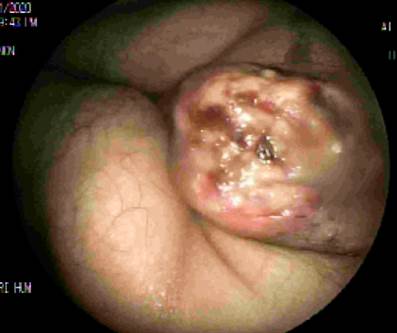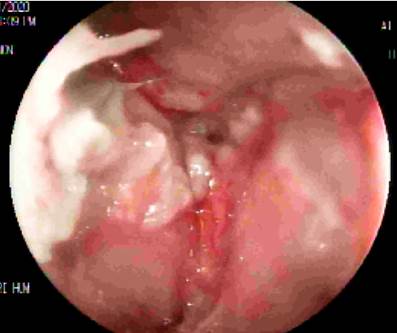Introduction
Malignant neoplasms of the anal canal are rare diseases, and anal lymphoma is one of the least frequent, comprising approximately 0.2% of anorectal tumors. it affects primarily young adult men in a 6:1 ratio; a critical factor associated with these tumors is human immunodeficiency virus (HIV) infection1. The low incidence of this pathology represents a diagnostic and therapeutic challenge for both clinical oncology and colorectal surgery groups. Cancers of the anus and anal canal represent approximately 2.4% of all gastrointestinal neoplasms1. They are the majority of these squamous cell cancers; however, there are other types of less frequent tumors, including lymphoma of the anus, which is a diagnostic and therapeutic challenge.
Clinical case
A 33-year-old male patient with a history of stage C3 HIV infection was admitted for a clinical picture of approximately three months of evolution consisting of sensation of perianal mass and pain, anal discharge, and intermittent rectal bleeding. On physical examination, a mass of approximately 4 x 5 cm was observed at the level of the anal canal, protruding through it. Digital rectal examination revealed an ulcerated, exophytic, friable mass that extended from the anal ridge up to 5 cm, infiltrated the external anal sphincter, and was in contact with the puborectalis muscle.
Within the extension studies, he had a contrast-enhanced magnetic resonance imaging (MRI) of the pelvis that showed a concentric thickening of the walls of the lower rectum, with an exophytic lesion that compromised the anal canal and extended towards the intergluteal soft tissues. The anal canal lesion had a longitudinal extension of 63 mm with an anteroposterior (AP) diameter of 73 mm and a transverse diameter of 40 mm with an adequate cleavage plane between the walls of the rectum and the seminal vesicles. The image described in the lower rectum made contact with the prostate posterior contour with nodes in the mesorectal fat with a diameter of up to 7 mm.
With this result and the findings upon physical examination, we decided to perform a rectosigmoidoscopy, finding a circumferential mass that extended from the anal rim to 5 cm, compromising 100% of the lumen and 95% of the circumference. It was obstructive and did not allow the team to advance, from which biopsies were taken (Figures 1 and 2). The histopathological report was a plasmablastic lymphoma with a positive immunophenotype for CD38, MUM-1, Ki67 95%, and CMYC in 70% of the tumor cells; and negative for cytokeratins, AE1/AE3, CD20, CD3, CD5, CD30, cyclin D1, Bcl2, Bcl6, PAX5, and CD10.
The diagnosis of plasmablastic lymphoma was made. We decided to perform a laparoscopic diverting colostomy, without complications during the postoperative period. Due to the patient’s history of HIV, in-hospital studies were performed that showed a CD4+ lymphocyte count: 23 cells/mm3 and a viral load of 16,803 replicates, with an indication to start chemoprophylaxis with trimethoprim/sulfamethoxazole and antiretroviral therapy with tenofovir, emtricitabine, and efavirenz.
Staging studies showed an abdominal computerized axial tomography (CT) scan with hepatosplenomegaly and a contrast-enhanced chest CT without evidence of lymphadenopathy or pulmonary nodules suggestive of secondary neoplastic disease. He was assessed by the haemato-oncology department, which considered that the patient had a stage IV BX plasmablastic lymphoma according to the Ann Arbor classification. We opted for management with systemic chemotherapy DA-EPOCH scheme for six cycles, with a partial response after the third cycle.
Discussion
Cancers of the anus and anal canal represent approximately 2.4% of all gastrointestinal neoplasms1. They are the majority of these squamous cell cancers; however, there are other types of less frequent tumors, including lymphoma of the anus, which poses a diagnostic and therapeutic challenge.
Lymphoma of the anus represents 0.2% of anorectal tumors, most of which correspond to non-Hodgkin’s lymphomas; Hodgkin’s disease at the anorectal level is even rarer1. This pathology affects more young adult men in a ratio of 6:1; an important associated factor is HIV infection, mainly when the CD4 count is < 100 mm3. Nevertheless, in recent decades, active antiretroviral therapy has decreased the incidence of HIV-associated lymphoma2. Anorectal lymphoma can be classified as primary if it refers to a primary neoplastic process of anorectal origin and secondary if it is a generalized neoplastic process in which anorectal involvement is caused by lymph node metastases3.
As already mentioned, primary colorectal lymphomas usually tend to be of the non-Hodgkin type; however, in some patients immunocompromised by HIV, the anorectal involvement could be of the Hodgkin type4. In this particular population, the involvement of the anal canal can reach up to 26%3,5.
The clinical manifestations of anorectal lymphoma are similar to those of adenocarcinoma of the rectum. The most frequent is the sensation of a perianal mass, chronic ulceration, and bleeding; in turn, B symptoms such as weight loss, abdominal pain, or fever may occur4. It is a problematic pathology; sometimes, the symptoms or diagnostic studies are misinterpreted. The clinical manifestation described in the world literature is diverse, from cases diagnosed postoperatively after hemorrhoidectomy6 to perianal abscesses7. Therefore, obtaining adequate samples that allow histopathological diagnosis is vital for establishing appropriate treatment.
Anal canal lymphoma is usually a tumor associated with HIV infection; however, other risk factors are described in the literature for its development, such as long-standing ulcerative colitis, transplant patients, pelvic radiotherapy, and immunodeficiencies of other causes5. Regarding diagnosis, imaging studies impede adequate differentiation from other types of lesions and most of the time, they are performed to evaluate the regional extension of the disease and rule out extranodal involvement4. The histopathological study provides the definitive diagnosis. Nonetheless, it continues to be a challenge because there are more than 60 varieties of non-Hodgkin’s lymphomas with different histological provide. It is often necessary to obtain multiple biopsies and various immunohistochemical markers that allow a definitive diagnosis4,8; the most common are diffuse large B-cell non-Hodgkin’s lymphoma and plasmablastic lymphoma, as in the previously described case.
Currently, the treatment is controversial, and there is no consensus about it; the most important thing is to define the extent of the disease, classify the type of lymphoma, and whether or not it is associated with HIV. Most studies suggest that the treatment of primary anorectal lymphoma could be surgical through oncological resection when it is a localized disease (Ann Arbor stages I-II), in which imaging findings classify it as potentially resectable. For example, high lesions could be treated with anterior resections of the rectum, while lower lesions that compromise the sphincters can be treated with abdominoperineal resections9,10. For advanced lymphomas (Ann Arbor stages III-IV), the treatment is systemic chemotherapy, of which there are multiple schemes11. Traditionally, multiple chemotherapy regimens have been administered for anal lymphomas, and the most used is CHOP (cyclophosphamide, doxorubicin, vincristine, and prednisone); nonetheless, adequate response and survival rates have not been achieved with this scheme10,12.
Due to the low frequency of this pathology, most studies conducted to date are retrospective and with a relatively low number of cases, without showing significant differences in overall survival and response to treatment; however, more recent studies suggest an improvement in survival with more intensive chemotherapy schemes such as EPOCH (etoposide, prednisone, vincristine, cyclophosphamide, and doxorubicin)13.
Radiotherapy treatment in lymphomas of the anus can be complementary, especially in local recurrences or in patients who underwent local resections with positive margins4. The overall survival rate is poor for anal lymphoma. Before highly active antiretroviral therapies (HAART), survival was eight months; now, the 5-year overall survival is 50% in localized disease, while for advanced disease with regional or distant metastatic lymph node involvement is 24% at five years4.
Conclusion
Primary lymphoma of the anus is an infrequent entity, representing approximately 0.02% of all anorectal tumors; primary lymphomas of this location are usually non-Hodgkin’s type, the population with the most significant relationship to this entity are HIV positive patients, and its management is surgical in early stages (Ann Arbor I and II). For more advanced lesions (Ann Arbor III and IV), treatment must involve systemic chemotherapy with EPOCH.











 texto en
texto en 





